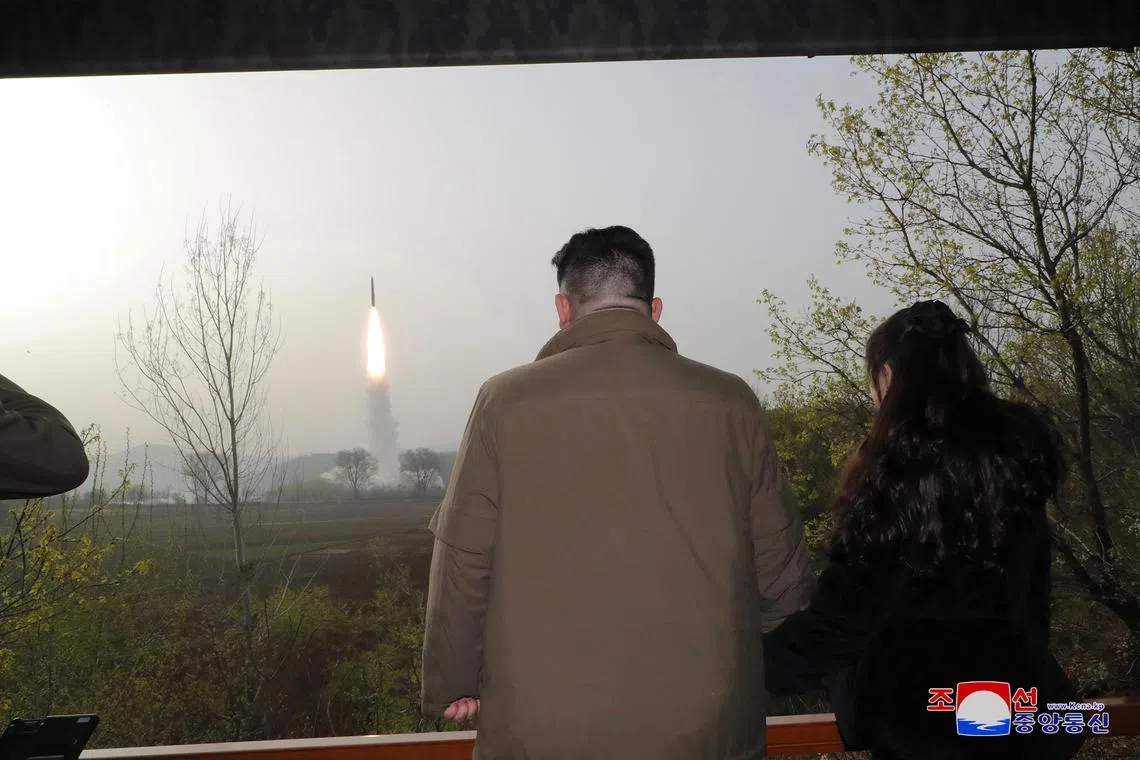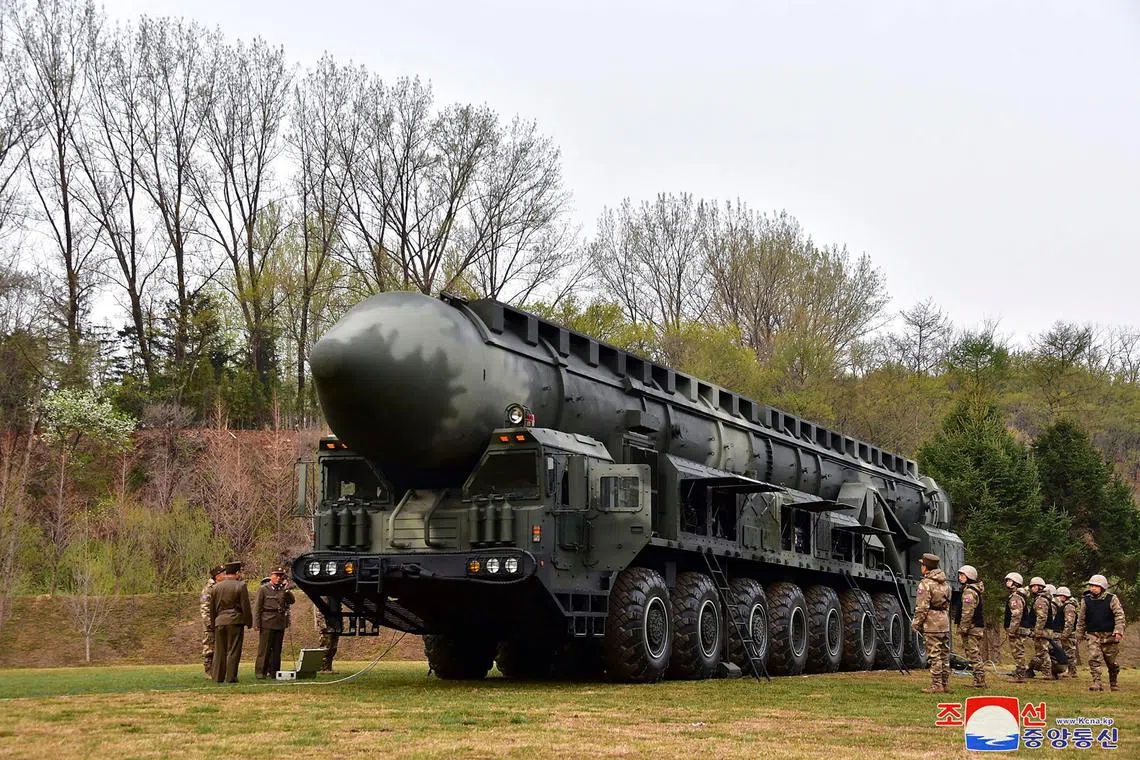5 things to know about North Korea's solid-fuel missile
Sign up now: Get ST's newsletters delivered to your inbox

North Korean leader Kim Jong Un and his daughter Kim Ju Ae observing the test firing of a new solid-fuel Hwasong-18 ICBM on April 13, 2023.
PHOTO: EPA-EFE
Follow topic:
SEOUL - Pyongyang said on Friday that it has successfully tested a new solid-fuel intercontinental ballistic missile (ICBM),
But what exactly is a solid-fuel missile and why does it matter that Pyongyang now has one?
Here is what we know:
What is a solid-fuel missile?
The propellant – the fuel that powers the missile – is made of a solid chemical mixture, which is combusted to create exhaust.
“This propellant is cast into the missile’s airframe when the missile is built: Imagine a firecracker rocket, ready to go,” Mr Ankit Panda, a nuclear policy expert at the Carnegie Endowment for International Peace, told AFP.
In contrast, liquid-fuelled missiles typically require that fuel and an oxidiser be inserted into the missile before they can be fired – a slower and more cumbersome process.
Why is it better?
Preparing a liquid-fuel missile for launch “takes time just like pumping petrol to your car”, said Dr Cheong Seong-chang, director of the Centre for North Korean Studies at the Sejong Institute.
A solid-fuel missile can be thought of more like a “portable battery”, which gives the user much greater flexibility, he said.
Moreover, once a liquid-fuel missile is prepared, “it has to be fired within a short period of time – which is not something you have to worry about with solid-fuel missiles”, he added.
Solid-fuel missiles need to be stored, maintained and handled carefully, and if this isn’t done, the quality of the missile can degrade over time which could cause it to fail, Mr Panda said.
But they are generally quicker to deploy and launch during a war compared with liquid-fuelled missiles. This “makes solid fuel missiles very attractive for a number of military applications”, he added.
So North Korea definitely has one now?
In state media images, it is possible to see the missile’s exhaust plume, which is “consistent with a dirty, smoky solid propellant at work”, said Mr Panda.
“Everything looks consistent with a successful solid-fuel ICBM test,” he added.
But even if the North Koreans have pulled off one successful test of the new weapons system, it will still “be likely some way from credible deployment in any meaningful numbers”, said Mr Joseph Dempsey, a defence researcher at the International Institute for Strategic Studies.

The new Hwasongpho-18 ICBM at an undisclosed location in North Korea.
PHOTO: AFP
With North Korea’s main liquid-fuelled ICBMs, which have been tested repeatedly – but only on a lofted trajectory, which is not how they would be used in a real-life situation – key questions remain over whether they are effectively operational.
But as North Korea’s “threshold for what is effectively fielded is likely different from others”, the new weapon may be considered operational even if other militaries would require more testing.
South Korea’s defence ministry said it believes the Thursday launch was simply an early test and that developing the Hwasong-18 properly “would need additional time and effort”.
“Pyongyang still faces many technical hurdles and resource constraints to actually deploy the missile forces it advertises in state media,” Associate Professor Leif-Eric Easley of Ewha University told AFP.
Who else has solid-fuel missiles?
Most militaries “first start off with liquid fuel missile technology but soon strive to acquire solid fuel missiles, which require more advanced technology”, said the Sejong Institute’s Dr Cheong.
However, not all advanced militaries exclusively deploy solid-fuel missiles.
“The United States does deploy all solid-fuel ICBMs and SLBMs, but Russia and China both still operate large liquid-fuelled missiles,” said Mr Panda.
South Korea, for its part, has the technical capacity for solid-fuel missiles, and even has some in its arsenal “but their range is limited to cover the Korean peninsula”, Mr Kim Jong-dae of the Yonsei Institute for North Korean Studies told AFP.
Is this a game changer?
North Korea’s Mr Kim claims the Hwasong-18 solid fuel ICBM will “radically promote” the country’s nuclear counter-attack capabilities, and experts say it could indeed change the security situation on the peninsula.
South Korea’s self-defence plan relies in part on a so-called Kill Chain pre-emptive strike system, which allows Seoul to launch a preemptive attack if there are signs of imminent North Korean attack.
The Hwasong-18 solid-fuel ICBM would be far harder to detect, which could upend this preemptive strike formula – although Seoul’s defence ministry on Friday dismissed this fear as “excessive worry”.
But if North Korea were to deploy solid-fuel ICBMs, it would “signal a game changer in possible warfare with them”, the Yonsei Institute’s Mr Kim told AFP.
“The South’s existing plan in case of war with the North is to preemptively strike and destroy the North’s missile system after confirming signs of launch preparations,” he said.
“But there will be no such signs if the North Koreans prepare solid fuel missiles aiming at the South.” AFP

